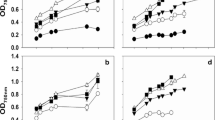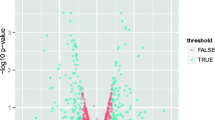Abstract
Silicon is involved in numerous important structural and functional roles in a wide range of organisms, including diatoms, plants, and humans, but clear mechanisms have been discovered only in diatoms and sponges. Silicate availability influences metal concentrations within various cell- and tissue-types, but a mechanism has not been discovered so far. In an earlier study on Baker’s yeast Saccharomyces cerevisiae it was proposed that a chemical mechanism, rather than a biological one, is important. In the present study, the interaction of silicon with Baker’s yeast is further investigated by studying the influence of zinc and magnesium on Si accumulation both at a low and a high silicate concentration in the medium. Si accumulation fitted well with Freundlich adsorption and Si release followed depolymerization kinetics, indicating that silicate adsorbs to the surface of the cell rather than being transported over the cell membrane. Subsequently, adsorbed silicate interacts with metal ions and, therefore, alters the cell’s affinity for these ions. Since several metals are nutritional, these Si interactions can significantly change the growth and viability of organisms. In conclusion, the results show that chemistry is important in Si and metal accumulation in Baker’s yeast, and suggest that similar mechanisms should be studied in detail in other organisms to unravel essential roles of Si.







Similar content being viewed by others
References
Lide LR (ed) (2002) CRC Handbook of Chemistry and Physics, 83rd edn. CRC Press LLC, Boca Raton Florida
Aston S (ed) (1983) Silicon geochemistry and biogeochemistry. Academic, London
Tréguer P, Nelson DM, van Bennekom AJ, DeMaster DJ, Leynaert A, Quéguiner B (1995) The silica balance in the world ocean—a reestimate. Science 268:375–379 DOI 10.1126/science.268.5209.375
Conley DJ (1997) Riverine contribution of biogenic silica to the ocean budget. Limnol Oceanogr 42:774–777
Willén E (1991) Planctonic diatoms—An ecological review. Arch Hydrobiol 69(suppl. 89):69–106
Petzold A, Hinz W (1978) Silikatchemie, Einführung in die Grundlagen. VEB Deutsche Verlag für Grundstoffindustrie, Leipzig (in German)
Iler RK (1979) The chemistry of silica. John Wiley & Sons, New York
Smith JV, Arnold FP, Parsons I, Lee MR (1999) Biochemical evolution III: Polymerization on organophilic silica-rich surfaces, crystal-chemical modeling, formation of first cells, and geological clues. Proc Natl Acad Sci USA 96:3479–3485
Epstein E (1999) Silicon. Annu Rev Plant Physiol 50:641–664 DOI 10.1146/annurev.arplant.50.1.641
Neumann D, zur Nieden U (2001) Silicon and heavy metal tolerance in higher plants. Phytochemistry 56:685–692 DOI 10.1016/S0031–9422(00)00472–6
Neumann D, de Figueiredo C (2002) A novel mechanism of silicon uptake. Protoplasma 220:59–67 DOI 10.1007/s00709–002–0034–7
Evered D, O’Connor M (eds) (1986) Silicon biochemistry. Wiley, Chechester
Simpson TL, Volcani BE (1981) Silicon and siliceous structures in biological systems. Springer Verlag, New York
Birchall JD (1990) Chem Brit 26:141–144
Seaborn CD, Nielsen FH (2002) Silicon deprivation and arginine and cysteine supplementation affect bone collagen and bone and plasma trace mineral concentrations in rats. J Trac Elem Exp Med 15:113–122 DOI 10.1002/jtra.10011
Valerio P, Pereira MM, Goes AM, Leite MF (2004) The effect of ionic products from bioactive glass dissolution on osteoblasts proliferation and collagen production. Biomaterials 25:2941–2948 DOI 10.1016/j.biomaterials.2003.09.086
Martin-Jezequel V, Hildebrand M, Brzezinski MA (2000) Silicon metabolism in diatoms: implications for growth. J Phycol 36:821–840 DOI 10.1046/j.1529–8817.2000.00019.x
Müller WEG, Krasko A, Le Pennec G, Schröder HC (2003) Biochemistry and cell biology of silica formation in sponges. Microscop Res Tech 62:368–377 DOI 10.1002/jemt.10402
Exley C (1998) Silicon in life: A bioinorganic solution to bioorganic essentiality. J Inorg Biochem 69:139–144
Schwieger W, Heyer W, Wolf F, Berg KH (1987) Zur Synthese von kristallinen Metallsilicathydraten mit Schichtstruktur. Z Anorg Chem 548:204–216 (in German)
Marshall WL, Warakomski JM (1980) Amorphous silica solubilities—II. Effect of aqueous salt solutions. Geochim Cosmochim Acta 44:915–924
Dietzel M, Usdowski E (1995) Depolymerization of soluble silicate in dilute aqueous solutions. Colloid Polym Sci 273:590–597 DOI 10.1007/BF00658690
Dietzel M, Böhme G (1997) Adsorption und Stabilität von polymerer Kieselsäure. Chem Erde-Geochem 57:189–203 (in German)
Dietzel M (2000) Dissolution of silicates and the stability of polysilicic acid. Geochim Cosmochim Acta 64:3275–3281 DOI 10.1016/S0016–7037(00)00426–9
Walker GM (1998) Yeast physiology and biotechnology. Wiley, Chichester
Brasser HJ, Krijger GC, van Meerten TG, Wolterbeek HT (2006) Influence of silicon on cobalt, zinc, and magnesium in Baker’s yeast Saccharomyces cerevisiae. Biol Trace Elem Res 112:175–190
Brasser HJ, Gürboğa G, Kroon JJ, Kolar ZI, Wolterbeek HT, Volkers KJ, Krijger GC (2006) Preparation of 31Si-labeled silicate: a radiotracer for silicon studies in biosystems. J Labelled Compd Radiopharm 47:867–882 DOI 10.1002/jlcr.1096
Verduyn C, Postma E, Scheffers A, van Dijken JP (1992) Effect of benzoic acid on the metabolic fluxes in yeast: a continuous-culture study on the regulation of respiration and alcoholic fermentation. Yeast 8:501–517
Adamson AW, Gast AP (1997) Physical chemistry of surfaces, 6th edn. John Wiley & Sons, Inc., New York
Coudurier M, Baudru B, Donnet JB (1971) Étude de la polycondensation de l’acide disilicique. III.—Influence de la concentration et de la température sur la cinétique et le mécanisme de la polycondensation de l’acide disilicique. Relation avec la texture des produits formés. Bull Soc Chim France 9:3161–3165 (in French)
Fein JB, Scott S, Rivera N (2002) The effect of Fe on Si adsorption by Bacillus subtilis cell walls:insight into non-metabolic bacterial precipitation of silicate minerals. Chem Geol 182:265–273
Stryer L (1981) Biochemistry. W.H. Freeman and Company, San Francisco
Kinrade SD, Hamilton RJ, Schach AS, Knight CTG (2001) Aqueous hypervalent silicon complexes with aliphatic sugar acids. J Chem Soc Dalt T 7:961–963
Kinrade SD, Del Nin JW, Schach AS, Sloan TA, Wilson KL, Knight CTG (1999) Stable five- and six-coordinated silicate anions in aqueous solution. Science 285:1542–1545
Lambert JB, Lu G, Singer SR, Kolb VM (2004) Silicate complexes of sugars in aqueous solution. J Am Chem Soc 126:9611–9625
Acknowledgement
The authors wish to acknowledge Ehsan Marandi and Jorrit Heikamp for experimental help and Tona Verburg for useful advises on statistics and modeling.
Author information
Authors and Affiliations
Corresponding author
Rights and permissions
About this article
Cite this article
Brasser, H.J., Krijger, G.C. & Wolterbeek, H.T. On the Beneficial Role of Silicon to Organisms: A Case Study on the Importance of Silicon Chemistry to Metal Accumulation in Yeast. Biol Trace Elem Res 125, 81–95 (2008). https://doi.org/10.1007/s12011-008-8148-1
Received:
Accepted:
Published:
Issue Date:
DOI: https://doi.org/10.1007/s12011-008-8148-1




